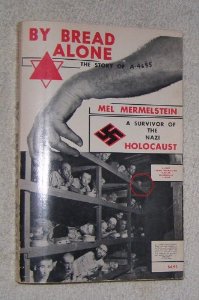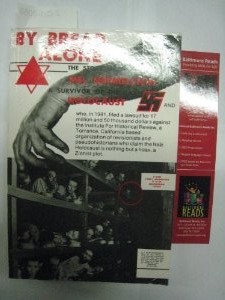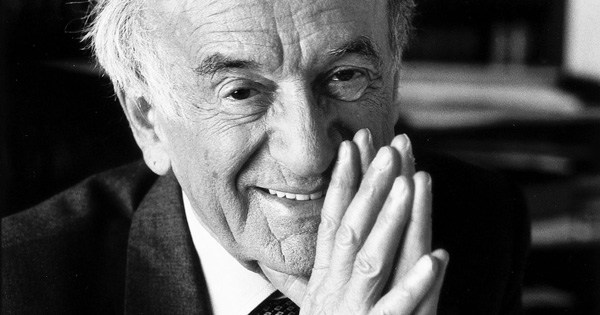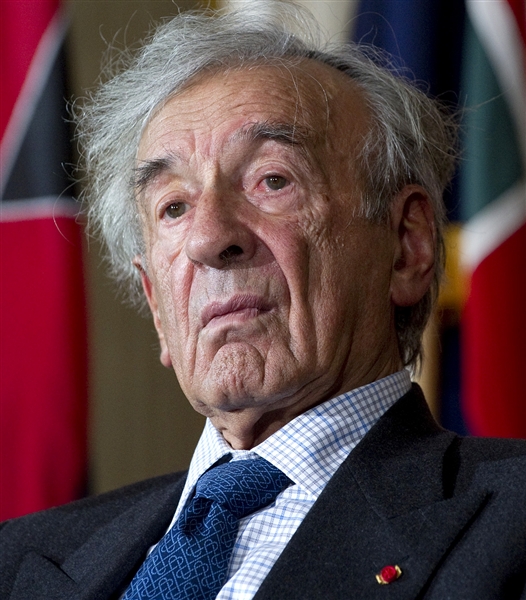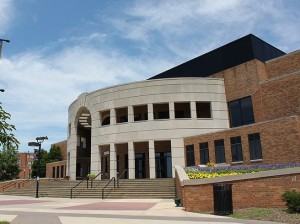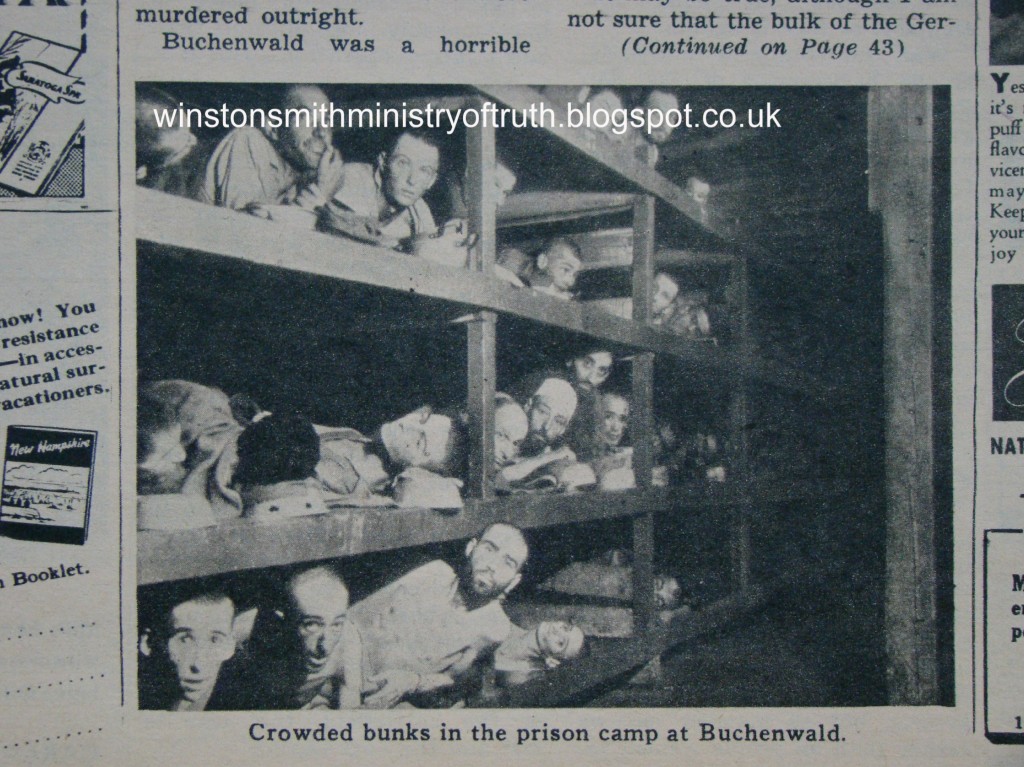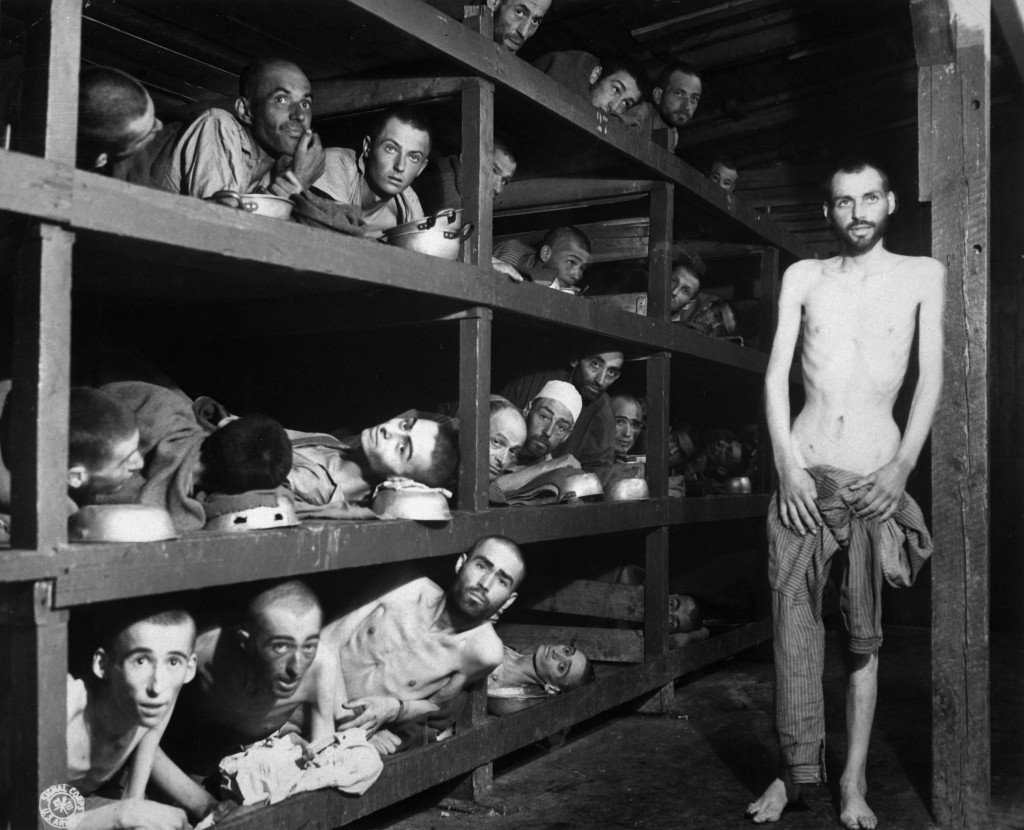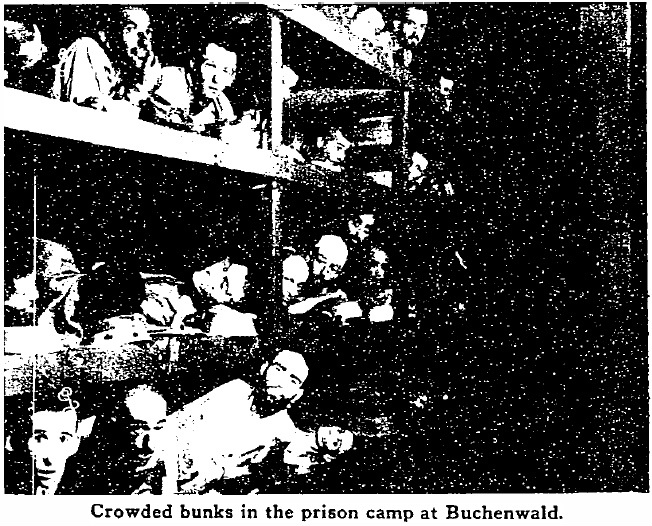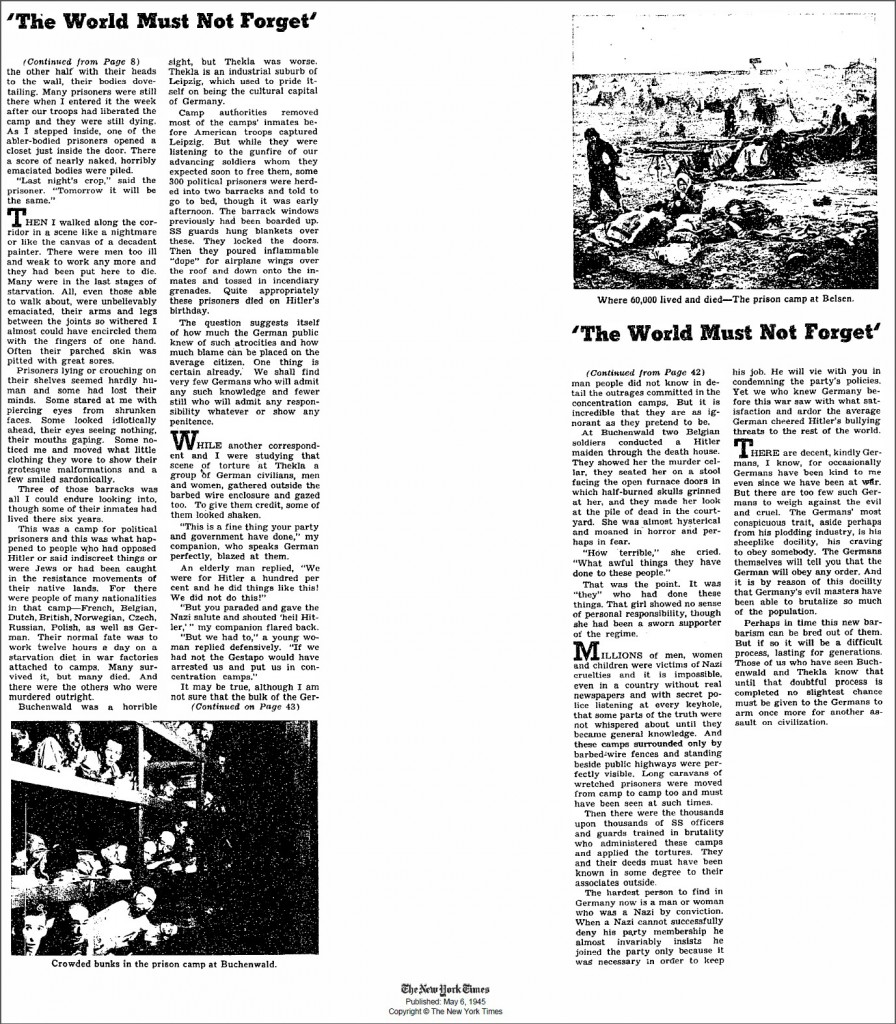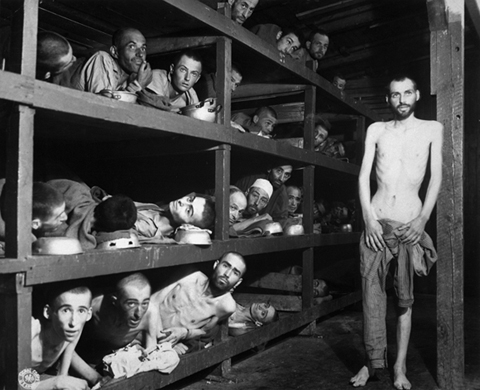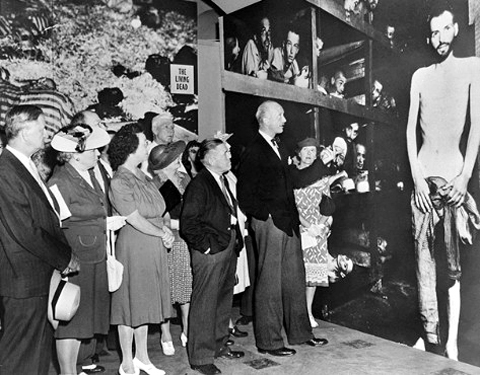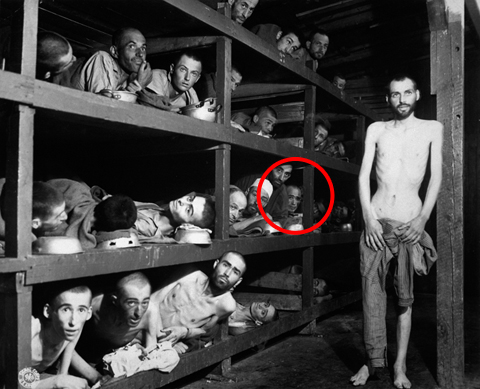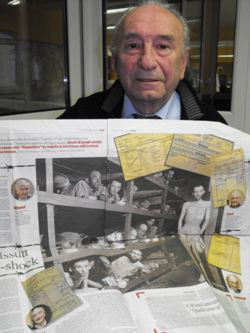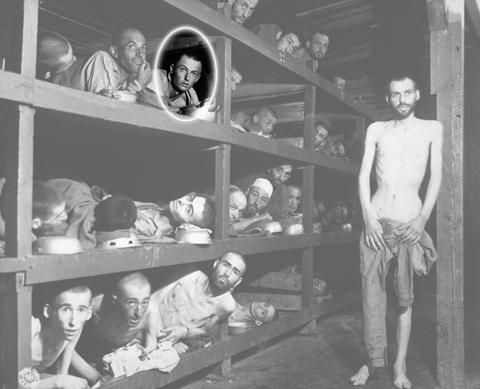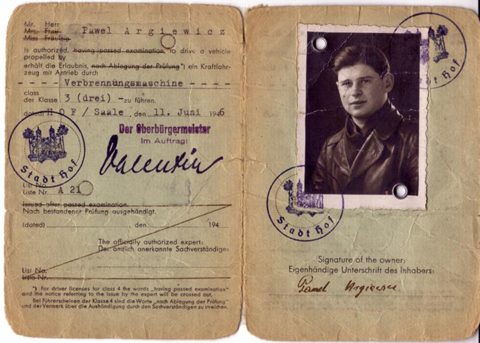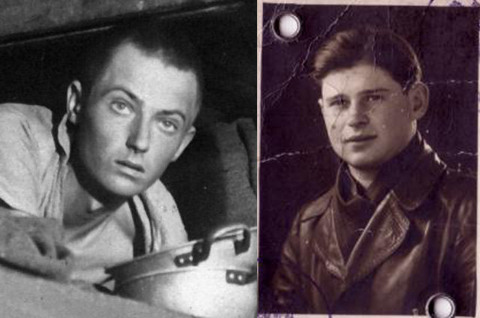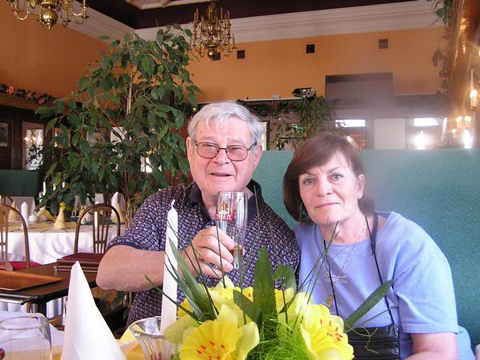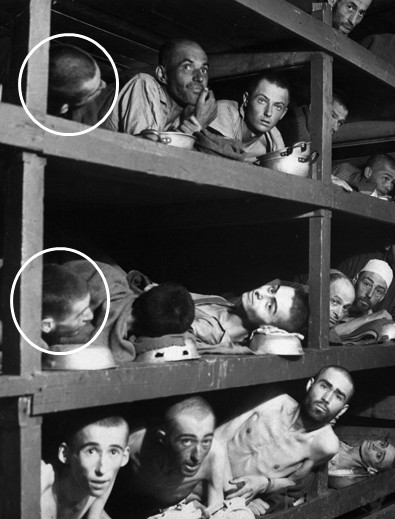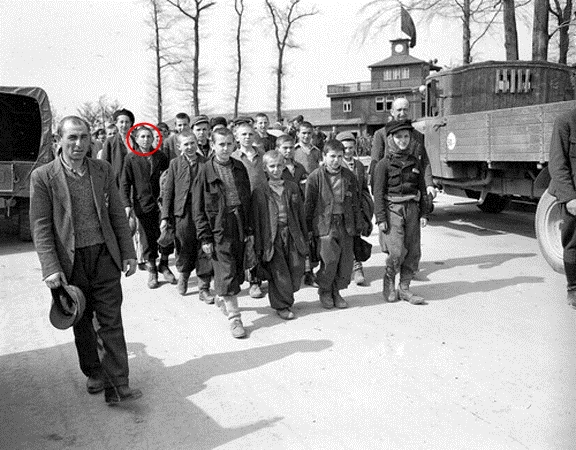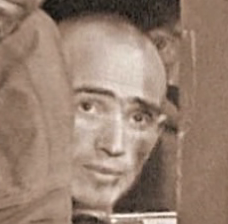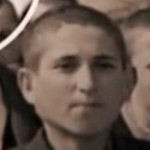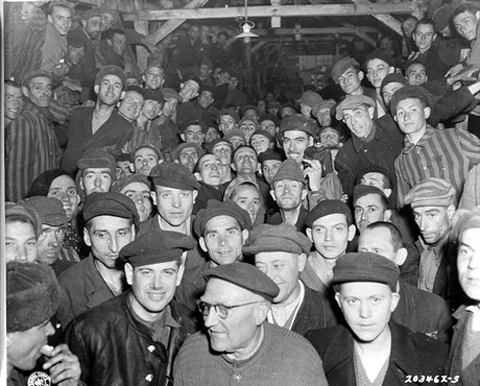Elie Wiesel was unknown to Mel Mermelstein in the Buchenwald Camp
By Carolyn Yeager
copyright 2013 Carolyn Yeager
According to our esteemed correspondent Attila Kovacs, his reading of Mel Mermelstein’s survivor story reveals no mention of the famous Elie Wiesel, even though the book first came out in 1979 when Wiesel and his own story was already well-known among the general public.
The first edition [right] was 264 pages, published by Crescent Books. In 1981, a second edition of the book [below right] came out, following Mermelstein’s dispute in 1980 with the Institute for Historical Review (IHR) over his claimed proof that even a single Jew was gassed at Auschwitz.
The second edition of By Bread Alone was published by the “Auschwitz Study Foundation” and retains the same cover design, but with some new text added referring to the author’s successful lawsuit. It is expanded to 290 pages from 264 pages in the first edition – an increase of 26 pages to include the lawsuit story. The new cover texts reads:
who, in 1981, filed a lawsuit for 17 million and 50 thousand dollars against the Institute for Historical Review, a Torrance, California-based organization of revisionists and pseudohistorians who claim the Nazi Holocaust is nothing but a hoax, a Zionist plot.
The only other change is that the price that was printed in red on the lower tab on the right side has been removed.
How well-known was Elie Wiesel in 1979?
It was 1978 when Wiesel was appointed by President Jimmy Carter as chairman for the Presidential Commission on the Holocaust (later renamed US Holocaust Memorial Council), indicating that he was at that time a recognized ‘authority’ on all things ‘holocaust.’ In fact, Wiesel claims that it was he who coined the term ‘Holocaust’ for the Jewish ‘Shoah,’ even though he doesn’t like the term. Typical Wieselspeak. That’s a term I just coined!
In 1979, Wiesel’s 15th book was published, the title being A Jew Today, a collection of essays, letters and diary entries weaving together all the periods of his life up until then. To put out a book such as that, one has to have a substantial following. Fifteen books by 1979! It is unimaginable that a Hungarian ‘survivor’ such as Mel Mermelstein would not be familiar with Elie Wiesel.
Attila Kovacs tells us what he discovered reading Mel’s book
In his own words he writes:
First, I must admit that reading the book the second time was somewhat of a struggle as there were so many confusing items, too many irrelevant, random photos, and the quality of the story left a lot to be desired from a strictly literary sense. The author jumps around as to his own identity as a Jew, (he is) a Hungarian Jew, a Czechoslovak, a Karpatho-Rus, and a Czech – to the point that I was confused as to what his main claim was as to nationality, mother tongue, ethnic origin.
But as to his being Hungarian, there is little doubt:
Lajos, his brother, Magda, his sister, and friends Joncsi (probably just a typo as Jancsi is a common Hungarian name), Pista, and Moric are all Hungarian names; in this regard, Etu may be Eti. His labor camp documents all say Ungarn, which is Hungarian in German. In addition, he refers to his hometown as Munkacs, which is Hungarian. It is telling in that the author did not use the Czech or Slovak spelling of Mukacevo or Mukaceve or the Ukrainian/Russian name of Mukacheve. Then on p. 17, he calls out to his father as ‘apu’ which is Hungarian for father.
As such, one has to assume that his mother tongue used in the home and in Munkacs and in the camps with other Hungarian Jews is Hungarian. In “Youtube” videos showing life in Munkacs in the 1930′s – the Jewish schoolchildren singing, a large town center wedding, and street conversations of the Jews are practically all in Hungarian.
Since in Elie Wiesel’s own “Youtube” video of his return visit to his hometown of Sighet he is speaking Hungarian with the old town folk, it seems that Moric (Mel) and Elie would have a lot in common and would converse in Hungarian at Buchenwald.
Yes, you would certainly think so. But one can get the impression that Wiesel is unable to converse comfortably in Hungarian because he often refuses to speak it in public. As he did with Nikolas Grüner in Stockholm. However, you would know this better than I.
The only reference in the book to Elie Wiesel is on page x, prior to the Forward, where it [quotes] a statement made by Professor Elie Wiesel of Boston University. So apparently the author knew of Professor Wiesel at the time he wrote the book.
There is a mention on p. 195 of “walked from one barracks (at Buchenwald) to another until I found Elijah, a frail bent youngster from Sighet.” There were a couple of other name mentions of Elijah, but nothing other than the name. So if this was indeed Elie Wiesel, one would think that the author would brag about this important Holocaust celebrity or their common roots, or their common experiences in the Munkacs-Sighet Jewish community, or about what they did together in Buchenwald especially with respect to the famous Buchenwald Liberation photo.
Yes, indeed. “Elijah” cannot be Elie Wiesel. For one thing, Wiesel was not frail and bent. The man he purports to be himself in the Famous Buchenwald Lie-beration Photo on Mel’s book cover is not frail looking at all. (Of course, I should hardly mention that since it’s been proven not to be Elie Wiesel.) But also, photos of Elie Wiesel in France from July-Sept. 1945 onward show a sturdy, vigorous, smiling lad with a head full of longish black hair. Plus Elijah was not an uncommon name amongst the Orthodox Hasidic sect of Hungarian Jews, and some from this sect were in the camp.
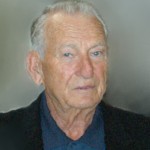 Does Mermelstein give many dates in his book? According to this source, he arrived at Buchenwald on or about February 10, 1945, he remained in the camp until it was liberated by American troops on April 11, 1945. That is only a 2-month stay. He was born on Sept. 25, 1926, making him exactly 2-years older than Elie Wiesel. He is now around 85. (recent photo of Mermelstein at left)
Does Mermelstein give many dates in his book? According to this source, he arrived at Buchenwald on or about February 10, 1945, he remained in the camp until it was liberated by American troops on April 11, 1945. That is only a 2-month stay. He was born on Sept. 25, 1926, making him exactly 2-years older than Elie Wiesel. He is now around 85. (recent photo of Mermelstein at left)
The same source also states this important information: In none of the numerous newspaper interviews he gave prior to 1980 (that we were able to discover) did he make any mention of seeing anyone go into any gas chamber [at Auschwitz-Birkenau]. Similarly, Mermelstein makes no mention of seeing his mother and sisters enter any building or “gas chamber” in the first, 1979 edition of his detailed memoir, By Bread Alone (written before the reward offer).
By the way, the liberation photo is only mentioned on p. 223. Less than one solitary page devoted to the cover picture which shows the author in the upper, most distant spot in the photo. Oh, well.
This confirms my theory in the previous article that 1) it did not mean as much to be in this picture prior to the identification of Elie Wiesel in it, and 2) Wiesel was not identified in it until 1983, after both editions of Mermelstein’s book had been issued. Even though Mel used the picture on the cover of both editions (without the standing man), it was probably only to prove that he was there and that it was as bad as he said it was. That the photo without the standing man was used on both editions also proves that it was not a mistake or an oversight; if it were it would have been corrected on the 2nd edition (unless, of course, this was a real low-budget operation and making a change on the cover was cost-prohibitive).
A can of worms has been opened here, there is no doubt about it.
What is most interesting is the disclaimer on page iv of the book, which I quote: “About the Characters in This Book – Though the characters in this story are real, I felt their names had to be changed to protect their privacy. I have not consulted with any of the survivors mentioned here, because I know how some might feel if the story of their part in the Holocaust were brought to them once again to be dealt with.”
Wow! Go figure then: why he would use his own name rather than a fictitious name; not want to fact check with known survivors; be concerned about privacy when others had written their own books (cannot recall how many in the photo have written their own books about Buchenwald and/or Auschwitz, etc.)
I don’t know of any book by anyone who was actually there; a lot of fraud is involved with this photo. But nevertheless, he certainly would not have changed the name of Elie Wiesel, since this man had already made his own experiences at Auschwitz and Buchenwald very well known. Mel could not speak of Elie Wiesel in Buchenwald because he never met or saw such a person there! Just like Nikolas (Myklos, Michael) Grüner, Mel Mermelstein was actually in Buchenwald (although he lies about what happened to his family and others) and thus his silence on Elie Wiesel completely refutes the testimony of Wiesel.
Nikolas Grüner and Morik Mermelstein are in the Buchenwald Lie-beration photo, but the fraud known as Elie Wiesel is not.
The author, Mr. Moric Mermelstein, does NOT mention or say anything about who (names or descriptions) was with him in the photo of barracks 56 on April 16th around noon.
Query: Whether or not an author in an iconic photo of yesteryear would not mention that in the old grainy middle school team photo the fact that Michael Jordan was in fact the scrawny, short but smiling kid at the end of row two sandwiched between the team water boy and a forgotten assistant coach?
Yes, Attila is so right. If such an “iconic” person were with you during a period of your life that you are writing about, and even in the same room — and a photograph existed that showed it — well, anyone would certainly mention it. There can be no doubt that Mr. Mermelstein’s book has given us more proof that Elie Wiesel is not in the Buchenwald picture. I don’t suppose Mel will be too pleased with helping our revisionist cause, but so he has. Thanks Mel! You won a battle, but you’re losing the war.
New (old) pictures come to light in wake of Elie Wiesel’s death
BY CAROLYN YEAGER
copyright Carolyn Yeager 2016
Though they say a picture is worth a thousand words, these two need some explanation. One is from 1987, the other from 2006. Since the more recent one will arouse much more attention, I better start with that.
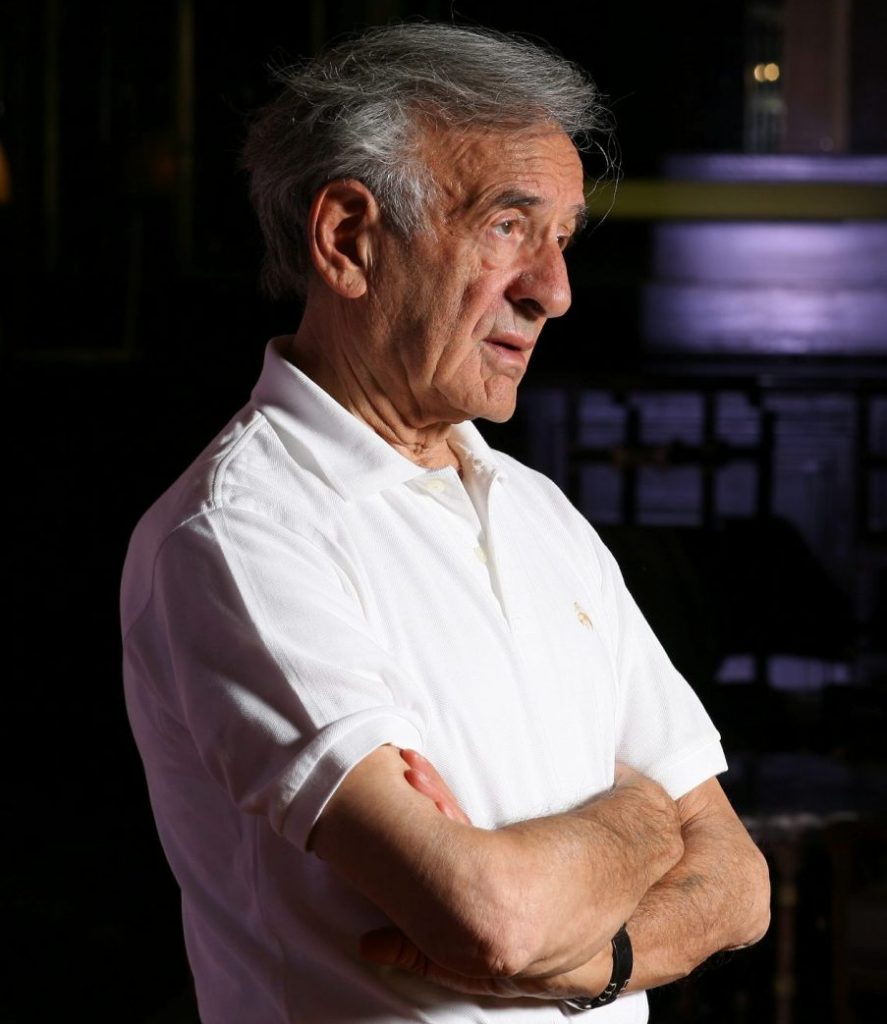
This 2006 photograph taken by Eyal Toueg, displayed in a July 9th “Premium” article by Shlomo Nakdimon at Haaretz, has been cropped by me to remove some of the dark space to the right … the better to see the important details. This may be the first time it has been published.
You will notice right away that there is a smudge on Wiesel’s left forearm, precisely where an Auschwitz tattoo would be. Many people will say, Oh, that’s his very, very faded and blurred tattoo. But it looks more like a bruise, and, by using your keyboard to enlarge the image while retaining a clear resolution, you’ll find, as I did, that it then looks even more like a bruise the larger you go. Plus there seems to be more bruise just above it where his right arm meets his left. [I’m speaking tongue-in-cheek here, and below. I don’t actually think it is a bruise, but all we can see, even highly enlarged, is a smudged blue area that looks like a bruise. So what are we to call it?]
[To enlarge the image, first click on it to get the full size image, then hold down the Ctrl key while clicking the plus (+) key as many times as you can or want. To bring it back to normal, do the same with the minus (-) key. Both keys are on the upper right next to “backspace”]
This photograph has to be from the same photo session that includes the one where he’s sitting with the oversize Hebrew book — he’s wearing the same white knit golf shirt and his hair is the same. That one has been used by Wiesel defenders to suggest there is a faint tattoo on his arm. You can see it here and here.
However, this kind of thing is the typical Wiesel mode of operation throughout his life. He refuses to be explicit about his person and his personal life, even though he gets very explicit about things like the “shades of wateriness of the soup” and the face of the boy he wrote was hanged in Auschwitz. But his own body–which can be checked–he offers not a word of description. And looking at this blue-black discoloration, I can see nothing—even with using all my imagination—that I could imagine to be a 7713. I know you can’t either, but you might try to come up with some theory about it. I have my own theory, that Wiesel pinched himself real hard the day before the photographer came.
In 2006 he was 77 years old, an age when it’s extremely easy to bruise the skin. And that’s what it looks like. Recall the tattoos of so many other inmates from his same time there — none look like this.
But I have a second theory, which might be better — that Wiesel had applied his own tattoo number with ink but he didn’t go deep enough. It was only applied to the dermis (outer layer of skin), not the epidermis, and so it disappeared over time as new skin cells grew until now it is just a smudge of dispersed ink. Remember the top photo on this page that doesn’t look like a real tattoo — this may be when he did it.
Now, the other picture indicts him even more. He is in Lyon, France for the Klaus Barbie show trial and stops by the Holocaust Memorial there on June 2, 1987. He just won the Nobel Peace Prize 6 months earlier, and this Buchenwald liberation photo was associated with him winning that prize. You recall right after the ceremony he traveled to Yad Vashem in Jerusalem and posed in front of a large blow-up of this very photograph.
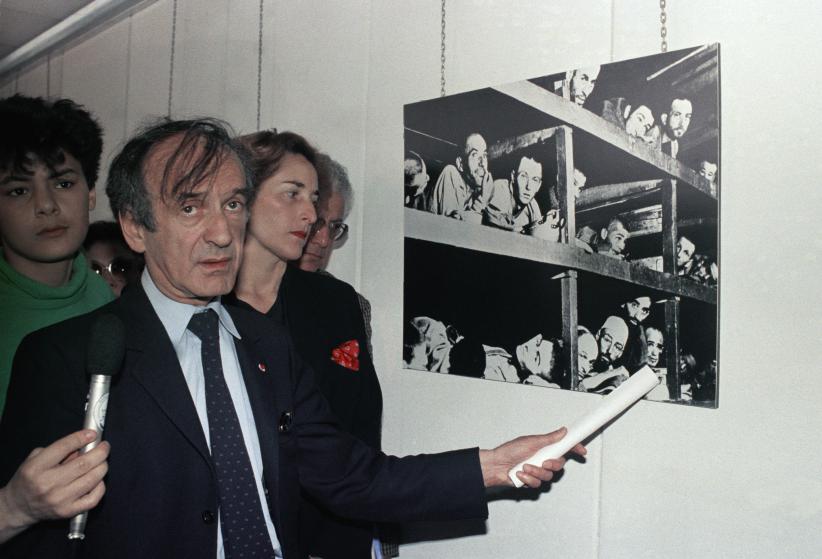
Elie Wiesel, winner of the 1986 Nobel Peace prize, visits the Holocaust Memorial in Lyon, France, June 2, 1987. The photo on the wall shows prisoners of the German Buchenwald concentration camp inside their barracks, five days after U.S troops took over the camp near Weimar, Germany. Wiesel points to himself in the picture. (AP Photo/Laurent Rebours)
Notice that Michael Grüner on the bottom row was cropped out of this version, along with the tall standing man, but there is Mel Mermelstein peeking out from the upper far right. Mel wrote a whole book about his incarceration before Wiesel said in 1983 that he was in this picture, but Mel never mentioned knowing the already famous Elie Wiesel there in his book! Mermelstein resided in the children’s barrack, too.
In this photograph, the unkempt Wiesel is sealing his doom by pointing directly to the unknown person (not him) he is claiming to be himself. And with such a guilty expression, too! Nothing could prove his dishonesty and forgery better than this.
I came upon this picture in the Time magazine Elie Wiesel photo collection posted at the time of his death. When I saw this one I quickly saved it. This might be my all-time favorite picture of the Wiesel. I will surely make more use of it.
Three must-read articles to give you the expertise you need on Elie Wiesel’s Big Con
By Carolyn Yeager
Here they are! These three articles, read in order, will explain why Elie Wiesel was not at Auschwitz or Buchenwald. If you carefully read and comprehend what is in these three articles, you will understand why this site is called Elie Wiesel Cons The World and you will be able to explain it to other people in a way that they are unable to refute. Do you see any real refutation (with sourced material) brought by visitors to this site? If you do, please let me know because I missed it. The three articles are:
1. When did Elie Wiesel arrive at Auschwitz ? Could he have received the number A-7713? This article proves that the answer to the second question is “no” … which makes everything else fraudulent and impossible.
2. Gigantic Fraud Carried Out for Wiesel Nobel Prize This article points out that the main evidence for Wiesel to have been incarcerated at Buchenwald is a famous photograph he purports to be in, which was used to win him a Nobel Prize. But the person identified as Wiesel is shown conclusively NOT to be Wiesel.
3. “Elie Wiesel was Not in Buchenwald” Made Simple Here, every piece of “evidence” used to place Wiesel in Buchenwald from the end of January to April 1945 is examined and shown not to apply.
If, after reading these three articles, you still believe in the legend of Elie Wiesel, please write to me and tell me why because to my mind they pretty much destroy it. One of the staunch upholders of the Wiesel-Buchenwald tale was Jewish Prof. Kenneth Waltzer. He tried to refute what this website was saying, only to be knocked down and out for the count. He is now retired from Michigan State University, where he had his special Elie Wiesel projects going, and is only loosely associated with a film titled Kinderblock 66: Return to Buchenwald in an historical advisory role. Wiesel’s role is similarly reduced to five words between parentheses – “(including among them Elie Wiesel)” – while other names dominate the film.
So what is the Wiesel Legend running on these days? In my opinion, the most important ingredient is that the mass public wants to believe it. They like the story of incredible suffering of a persecuted people. They like the man who has been put into the center of the story, the man who survived against all odds and “turned the tables,” so to speak. They don’t know that Wiesel privately laughs at them for their gullibility. Family members have let on to that in the past, but their words have been scrubbed away. Elie Wiesel is putting us on and the majority of us fall for it! He even admits he makes things up … but he excuses it this way:
In [my] book “One Generation After” there is a sentence which perhaps explains my idea: “Certain events happen, but they are not true. Others, on the other hand, are, but they never happen.” So! I undergo certain events and, starting from my experience, I describe incidents which may or may not have happened, but which are true. I do believe that it is very important that there be witnesses always and everywhere.
In other words, he is a false witness, but a witness nevertheless. He sees nothing wrong with that because the over-all “Holocaust” story is important for Jews and Israel, and relies on witnesses. There can never be too many witnesses, no matter if they were actually there or not. Even if what he “witnessed” did not actually happen, it is true (in his mind) because the conditions (he thinks) were such that it could have happened. Got that? Elie Wiesel is just the most famous false witness, but multiply him with thousands of others and you have … “The Holocaust”.
So our job, the few enlightened ones, is to get the mass public to pay attention, and to force this information into the mass media. You could start by circulating the three articles above, and selecting them on search pages enough times to get them to the top of the page. Elie Wiesel Cons The World is quite competitive as far as visitors go, in spite of the ridiculously low and inaccurate rating given it by Alexa. It is popular because many young people and students search the subject regularly. Our job is also to have all our facts straight and not be stuck in the low aspiration of only wanting to show that Wiesel exaggerates or lies about what he saw in the camps. If he was in the camps, he will receive sympathy no matter how many lies he tells. But if he wasn’t there – that is the shocker and changes the whole dialogue. And from all the evidence, he wasn’t.
Let’s be courageous and go where the evidence takes us. To be a top-notch ambassador for truth and freedom from political lies, you should also try to read and study these important articles:
Night #1 and Night #2 – What Changes were Made and Why, Part One and Part Two
Both contain original translations from the Yiddish forerunner of La Nuit and Night to reveal the what and the why of the changes that were made by Marion Wiesel in the new 2006 edition.
Elie Wiesel was unknown to Mel Mermelstein in the Buchenwald Camp A famous survivor of Buchenwald who lived in the “children’s block” didn’t mention Elie Wiesel in his 1979 book.
Signatures prove Lázár Wiesel is not Elie Wiesel The signature on the back of the Buchenwald “release” questionaire had been overlooked until I noticed it was unlike Wiesel’s known signature.
Questions on Elie Wiesel and the Sorbonne Great examples of how Wiesel invents his past.
Elie Wiesel and the Mossad Part 2 Part 3 Part 4 Amazing story of Wiesel’s ties to the Irgun and Israel from his earliest days in France; his trips to Israel and his role as a translator and journalist during the German-Israel Reparations negotiations; his move to New York and involvement in bringing Soviet Jews to Israel. Concludes that Wiesel has always been an asset of the Mossad.
The Shadowy Origins of Night Part 2 Part 3 How the book Night came about and the impossibility of it happening the way Wiesel says.
You will find that the common thread in these 9 articles is to reinforce my original statement. This is very powerful. You can put it together for yourself in your own way, but I will try to summarize my findings even more clearly in a future article.
Why Doesn’t Elie Wiesel Sue Me for Libel?
By Carolyn Yeager
Have you ever wondered that? I sure have. If this website Elie Wiesel Cons The World is telling lies about him, it would be the natural thing to do. In the same vein, if Elie Wiesel has the number A7713 tattooed on his arm, as he says he does, it would be very easy to show it to the world and put me out of business. It is inexplicable that he doesn’t do it if he could. The only logical conclusion to reach is that he can’t … because he doesn’t.
Not only does Elie Wiesel not sue me, he doesn’t go after Nikolaus Grüner either, who called him a liar before I did. Grüner did try to sue Elie Wiesel, though, but was prevented from doing so by the courts and legal systems that protect Wiesel according to Zionist orders.
I’m told the United States Holocaust Memorial Museum closely follows this blog. I have said many negative things about the museum, too. For instance, that it is a criminal conspiracy to defraud the American people — certainly to defraud the American taxpayers out of fifty or so million dollars a year. I have accused the USHMM of blatant lying, of perpetuating false information even after it knows it is false, of creating an atmosphere of hate against anyone Jews don’t like. And, yes, of being totally run by Jews for Jewish interests — not the interests of history — very similar to the OSI (Office of Special Investigations) in it’s disreputable and downright illegal tactics.
I will be doing a new article on the relationship between these organizations — in 2010 the OSI was merged into the Human Rights and Special Prosecutions Section of the Domestic Security Section of the Justice Dept.
Elie Wiesel and the USHMM – a mutually beneficial relationship
I have previously written about the symbiotic connection between Elie Wiesel and the national holocaust museum he was instrumental in creating in this country – the USA. Built in Washington D.C. on federal ground amidst the national monuments to American history, this parasitical monstrosity pretends to be something that helps to insure the American idea of freedom and democratic principles around the world!
A faithful reader recently wrote to me:
Did you know the USHMM was closely following your blog?
Two weeks ago, I landed on the Oral History site; I did not intend to watch the VDO, but scrolling down the page, saw there was a clickable link to the transcript of the interview in .doc or .pdf format. That’s quite handy and I downloaded a couple every day till the 26th, when I posted my comment [here at EWCTW] with a link to their site on one of the rare pages without a clickable link. Guess what? – on the evening of the very same day each and every link had been disabled.
Well these testimonies have been recorded in the late 80s or early 90s, before the advent of the net and they believed they could get away with telling anything … (Bomba tells he dug a bunker in the ghetto for 50-60 people, loading it with food for 2 YEARS, apparently in a matter of days … to fifth-graders).
I am not surprised at that. I too see changes based on what is exposed on Elie Wiesel Cons The World. Just one example is Wiesel’s now more secret visits to Chapman University after I so effectively panned his first visit as a “Distinguished Presidential Fellow” in March 2011, based simply on what I read in the local and campus newspapers. We also had a fellow, Steve, pass out flyers at a Wiesel talk during that same visit. Since then, Wiesel’s visits and talks have been handled differently. In his 2012 visit to Chapman, there was no publicity and Wiesel only appeared to students in very private and secure settings. So far, there have been no announcements of his 2013 visit that I have seen.
So they react, but they are careful not to ever mention this web site or my name in any way. To object in any way about it or me would mean they would have to show, demonstrate, prove, provide evidence or give testimony that I am wrong. They know beforehand they cannot do that because they know they are the liars, not me. They depend on the news and entertainment media to keep the public believing they have noble aims.
I would have to say that Elie Wiesel and the USHMM are afraid to touch this web site because of the deep research I have done, to which they have no answers or rebuttal. Without the power of the media covering for them, and all branches of the U.S. government backing them, they would wither and die from their lack of credibility.
Their chosen method is to stay in generalities and avoid specifics
The powers that are behind Elie Wiesel and the USHMM know that they can only succeed by using generalizations like “hate,” “genocide,” “anti-Semitism,” “religious persecution,” “6 million,” etc. along with such vague “legal” language as “stirring up racial hatred” and “encouraging contempt for individuals or groups”. No legal system that has acquiesced to what the Jews want in the way of protections for themselves will allow for introduction of evidence that actually pertains to truth or falsehood of specific elements of the narrative.
Both Elie Wiesel and the USHMM make specific charges against those they call the perpetrators of evil, but they will never answer to the denial by said “perpetrators” that they committed these evils. Via the total postwar power assumed by the victors of World War II (those who brought about WWII in order to gain this power!), this question was never allowed consideration. Again, it was the media that did the job.
Legal Definition of libel
1) n. to publish in print (including pictures), writing or broadcast through radio, television or film, an untruth about another which will do harm to that person or his/her reputation, by tending to bring the target into ridicule, hatred, scorn or contempt of others.
What I do here seems to fit that (apart from the word “untruth”), but there is no response from those who are so targeted. Of course, my intention is to discover and to tell the truth, not to slander. The only complaints I get are a few comments, and once in awhile an email, from ardent fans of Elie who chastise me for being insensitive to the man’s suffering — which to their illogic means to them he can have no reason to lie about it and would only tell the truth. (And if he doesn’t, well – that is excused on the same grounds.) To their thinking, Jewish suffering excuses all moral failings. These writers are mostly female and young, appearing as though they had looked up Elie Wiesel on the Internet, come upon this site and were shocked by it. Unfortunately, these young’uns would be the first to use the “chosen method” described above, that is, to judge harm done according to “selected” peoples’ feelings. That is the only way anyone will ever touch it.
Elie Wiesel to speak at Ohio Kent State University in April
Kent State President Lester Lefton said the university is expecting thousands of people from across the region to attend on April 11, 2013 when Elie Wiesel speaks as part of the “Presidential Speaker Series.”
The PSS is a project only in it’s second year that “seeks to bring high-profile, world-renowned experts to Kent State for serious, thought-provoking discussions and conversations,” according to the KSU website. But will there be discussion and conversation with Wiesel while he is there? I’m sure not, as Wiesel never takes any questions from an audience (or from anyone anywhere) since so many people have gotten wise to the big fraud he is perpetrating. Wiesel will be whisked in and whisked out through secret passageways with no chance for anyone to interact with him. Expect security to be very tight.
The speech will be given at Kent State’s main campus at 7 pm in the Memorial Athletic and Convocation Center (pictured right), which is located at 1025 Risman Drive, Kent, OH 44242. Detailed directions from all points can be found here. The center has a capacity for 6,327. Assuming an average of $10 per person, that could add up to $63,270. How much of that will Elie Wiesel get?
Wiesel charges a minimum of $25,000 per speech (as of a couple years ago), so those who go gaga over the man’s sentimental words, which are pretty much the same every time, should remember how much he’s being paid to utter them. If you think he ever does anything without getting the highest price the market will bear, you are just misled.
Fifteen hundred free tickets are available now to Kent State students (one ticket per student) on a first-come basis. After the first 1,500 free tickets are gone, Kent State students pay $10 for one ticket and the general admission price of $20 for any additional tickets. It costs $50 for preferred seating (where you can actually see the man). If you buy tickets for a group of 10 or more, the price goes down to $15 per ticket.
What draws Wiesel to Ohio?
It was April of last year, 2012, that Wiesel spoke at Xavier University in Cincinnati, Ohio. A little searching discovered it was sponsored by The Jewish Foundation of Cincinnati with their partners The American Jewish Committee, Cedar Village, Jewish Community Relations Council, The Jewish Federation of Cincinnati, Jewish Vocational Service and the Issac M. Wise Temple. In other words, it was an all-Jewish production.
There is undoubtedly a substantial Jewish community in Ohio that is active and well-organized. They provoke an artificial demand for Elie Wiesel, then much of the non-Jewish population is persuaded it’s a wonderful thing, too. Kent State is making every effort to build an increasingly multi-racial student population – it is evident from browsing through their website.
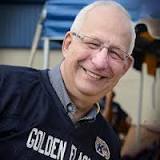 Is KSU President Lefton Jewish?
Is KSU President Lefton Jewish?
It is my opinion that Lester Lefton (left) looks Jewish. Neither on his Wikipedia page, nor on his official Kent State bio page was any religion or family background given – which is highly unusual for an academic and major university president. We’re only told:
Born in Brookline, Massachusetts, Lefton completed his bachelor’s in psychology from Northeastern University in Boston in 1969.
and
Lefton resides in Kent, Ohio with his wife, Linda. They have two grown daughters and three grandsons. Mrs. Lefton is an attorney who served as a state prosecutor in South Carolina and was an academic advisor for pre-law majors at George Washington and Tulane universities
In a news article/PR release from June 21, 2011:
News of a new partnership with Siauliai University brings Kent State’s total number of international connections to approximately 200. That number includes university partnerships, exchange programs, short-term study abroad arrangements and full semester study abroad programs.
This is just one of many indications of the direction President Lefton is taking Kent State. He has also been involved in scandal over his expense account charges to the university.
Between July 2006 and July 2007 Lefton expensed $36,741.93 on entertainment and $44,249.34 on travel.[28] In a Sep 26, 2007 editorial in the Akron Beacon Journal Lefton was criticized for extensive travel to Europe, a portion of which was charged to the University, as well as hiring two additional vice presidents during a time when university tuition and fees increased for students.
Further controversy in 2007 included an agreement to pay $88,000 for a Vice President to pursue a doctorate at Case Western University. This came at a time when the university was raising student tuition and was of further concern because the same degree could be earned at Kent State University.[30]
Unfortunately, links found in footnotes 28, 29 and 30 on Lefton’s Wikipedia page are no long viable; the stories have been removed. The power of Jewish media at work?
Do we have Ohio residents willing to protest Wiesel’s appearance?
If there were a large enough group (five or more) outside the Convocation Center, or at any good campus location in the week prior to Wiesel’s speech, it could be effective. Signs are sufficient; no need to hand out flyers, but some should be available for anyone who asks for it. Two items demand attention at this time:
- The perennial question “Where is Elie’s Tattoo?” “Show the American people your tattoo, Elie!”
- What about the missing standing man in the Buchenwald Lie-beration Photo that Wiesel says he is in? We would like a comment from Wiesel on the photo in the article from the New York Times and the cover of Mel Mermelstein’s book that both show that photograph without the tall, naked man. And what about Mermelstein never mentioning Wiesel in his 1979 book about his internment at Auschwitz and Buchenwald when they were only 2 years apart in age and both were part of the Hungarian deportation in 1944?
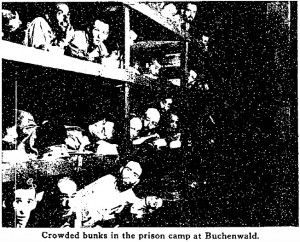 Copying images from this website and getting blow-ups made to paste onto posters seems to me a doable thing. It’s best to start organizing now, contacting others you know in Ohio and especially the Kent, Ohio area. I know Ohio is well-populated with men and women who consider themselves part of the Truth Movement. Heck, even Gordon Duff lives in Ohio and he fashions himself on VT as some kind of “holocaust revisionist.” He should act the part and get out there and challenge Elie Wiesel’s version of history. And remember, you don’t have to be a “holocaust denier” to object to the false testimony of Elie Wiesel! Don’t let anyone get away with labeling you with that. Be brave, and spend some of your valuable time for the truth. This may be the last opportunity you’ll have to protest Elie Wiesel in person before death turns him into an eternal martyr and saint.
Copying images from this website and getting blow-ups made to paste onto posters seems to me a doable thing. It’s best to start organizing now, contacting others you know in Ohio and especially the Kent, Ohio area. I know Ohio is well-populated with men and women who consider themselves part of the Truth Movement. Heck, even Gordon Duff lives in Ohio and he fashions himself on VT as some kind of “holocaust revisionist.” He should act the part and get out there and challenge Elie Wiesel’s version of history. And remember, you don’t have to be a “holocaust denier” to object to the false testimony of Elie Wiesel! Don’t let anyone get away with labeling you with that. Be brave, and spend some of your valuable time for the truth. This may be the last opportunity you’ll have to protest Elie Wiesel in person before death turns him into an eternal martyr and saint.
Cover of survivor’s book features Buchenwald Lie-beration photo without standing man.
By Carolyn Yeager
copyright 2013 carolyn yeager
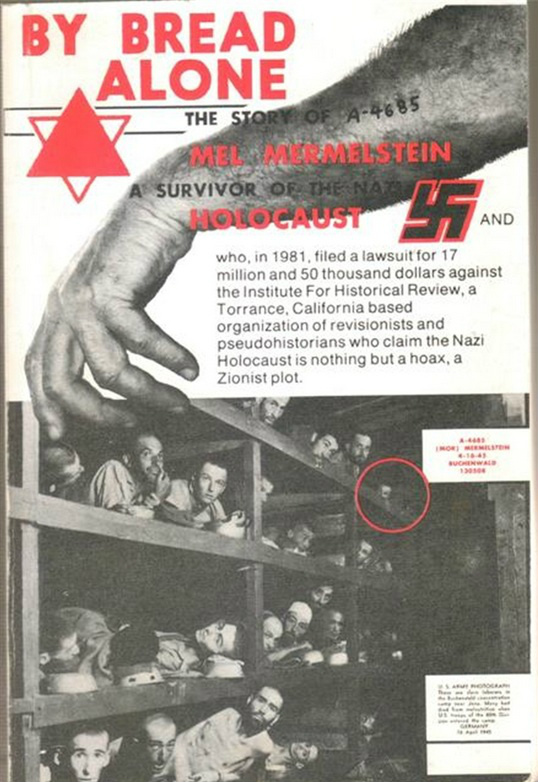 Once again, a helpful commenter on this website has brought us an important discovery. Thanks to Attila Kovacs, I looked up Mel Mermelstein‘s 1979 “survivor memoir” titled By Bread Alone: The Story of A-4685 and discovered just what Kovacs reported — that the Famous Buchenwald Liberation Photo that is on the cover of the book (with Mel’s face circled in red) does not contain the tall standing man. In Kovacs’ words: “What is not shown on the cover photo is the tall man standing on the right leaning on the post. The post is there, but why then not the man standing?” Good question.
Once again, a helpful commenter on this website has brought us an important discovery. Thanks to Attila Kovacs, I looked up Mel Mermelstein‘s 1979 “survivor memoir” titled By Bread Alone: The Story of A-4685 and discovered just what Kovacs reported — that the Famous Buchenwald Liberation Photo that is on the cover of the book (with Mel’s face circled in red) does not contain the tall standing man. In Kovacs’ words: “What is not shown on the cover photo is the tall man standing on the right leaning on the post. The post is there, but why then not the man standing?” Good question.
Another helpful reader supplied the larger image of the book cover, from Google Images! I confess, I never thought to look there. Thanks Simon! Now you can even more clearly see the post on the right edge of the picture, with no one standing beside it – just dark, empty space.
Kovacs continues, “On page 208 of the book, the same photo is reproduced, but magically the tall standing man is included in this photo. What the heck is going on?”
What seems to be going on can be explained this way: Elie Wiesel was not identified in that photograph until the 1980’s. As I have written elsewhere, it was a decision made to increase Wiesel’s chances for a Nobel Prize. He wanted one, and his supporters began in 1983 to lobby the Nobel committee and plant news stories that he was being considered for either the Peace Prize or the Literature Prize. In 1986, the Peace Prize was awarded to him. The first thing he did as follow-up was to travel to Yad Vashem holocaust memorial in Israel to express his appreciation and get photographed in front of a wall-size blow-up of that famous picture.
Why are these dates important?
Mermelstein’s book came out in 1979; Elie Wiesel was first identified in the photo around 1983, so Mel would not have been aware that one of the men laying just two rows below him was (supposed to be) Elie Wiesel. He would also not remember a man standing naked when the photograph was taken … since there wasn’t one. When he saw this picture for the cover, it would have looked right to him. An editor may have added the pictures inside the book, without realizing the discrepancy with the one on the cover. We have already seen evidence of how most people miss sensing anything wrong when viewing the picture without the standing man.
An alternative explanation could be that the standing man was too dominating in the picture, taking visual attention away from Mel the author, who was way back in the upper bunk, barely visible. If this were true, however, it would verify that there are indeed two versions of the picture known — one with and one without the “naked” man. But also, since it has already been proven that this standing man was added by “photo composite” techniques known at the time, we know that he was not in the original photograph taken on that day.
 This image (left) from a story in the New York Times, May 6, 1945 is exactly the same as what is on Mermelstein’s book cover. We can see the post, everything is there except the standing man next to the post. The man has not been ‘removed’ – he was never there. Those who want to argue that he was removed should provide an explanation of why and how that was done if they want us to believe it.
This image (left) from a story in the New York Times, May 6, 1945 is exactly the same as what is on Mermelstein’s book cover. We can see the post, everything is there except the standing man next to the post. The man has not been ‘removed’ – he was never there. Those who want to argue that he was removed should provide an explanation of why and how that was done if they want us to believe it.
Does Mermelstein write in his book about meeting Elie Wiesel at Buchenwald?
I can’t find a readable version of the book online, but since Attila Kovacs has a copy we can ask him: What does Mermelstein say about Elie Wiesel being in the famous photo with him? If he says nothing, that is further proof of Wiesel’s chicanery. In looking at reviews of this book, I don’t see Elie Wiesel’s name anywhere. I am under the impression that the book is more about Mel’s lawsuit against the Institute for Historical Review than about his experience in the camps. So we’ll leave it here for now and see what more Attila Kovacs can tell us.
UPDATE: Feb. 10
For those who want to see a better quality image, this was taken from Winston Smith Ministry of Truth website. He obtained an original NYTimes Magazine from May 6, 1945. However, the man 2nd from the right in the upper row (to the left of Mermelstein) is not the same face or person as the standing man, as some want to believe.
Discovered! Iconic photo in Buchenwald is dishonest photo-fakery
By Carolyn Yeager
copyright 2012 carolyn yeager
This is the photograph that Allied Supreme Commander General Dwight David Eisenhower ordered, in April 1945, to be posted in every German town and city 1 to show the defeated population the “true meaning of Nazism.”
Was this photo made to order according to Ike’s specifications?
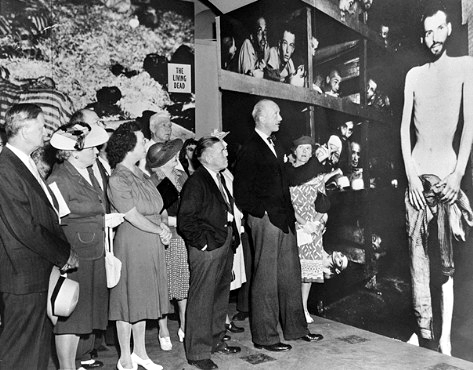 A huge blown-up version then went on tour in the United States for the same purpose, to impress on the American people what evil they had gone to war against; why the sacrifice of blood and treasure was justified! Left: “A traveling exhibit of larger than life size photographs was first shown in St. Louis, MO in summer 1945 and then taken to Washington, DC.
A huge blown-up version then went on tour in the United States for the same purpose, to impress on the American people what evil they had gone to war against; why the sacrifice of blood and treasure was justified! Left: “A traveling exhibit of larger than life size photographs was first shown in St. Louis, MO in summer 1945 and then taken to Washington, DC.
It was plastered on the front pages of newspapers across the country. Thus it became one of the most iconic images representing WWII and of what later came to be known as “The Holocaust.” The intention was to portray the war as a noble effort to “save the Jews from enslavement and extermination,” just as the equally bloody American Civil War had come to be taught as a war “to free the slaves,” i.e. the Negroes who were not citizens of the country they were living in.
Both are black propaganda campaigns that still use whatever is at hand, whether it be subterfuge or not.
In the case of the above photograph, we have learned that the standing figure, the part that makes the biggest, most memorable impact on the viewer, was added later – it was not in the original photo allegedly taken by Private H. Miller of the Civil Affairs Branch of the U.S. Army Signal Corps on April 16, 1945, five days after the “liberation” of the Buchenwald Concentration Camp by American forces.
A blogger, the owner of the Winston Smith Ministry of Truth website who goes by the nickname Black Rabbit, decided a week or so ago, out of curiosity, to order the New York Times newspaper article from May 6, 1945 in which this photo was published, and when it came the photo looked like this:
Here is page 2 and 3 of the New York Times article (click to show entire page):
What a shock to see only an empty dark space, and in the New York Times no less!
What happened to the standing man? I was the first to bring it to the attention of the participants in the comment section of furtherglory’s Scrapbookpages Blog after Black Rabbit posted a link to the original article there, and then we quickly began noticing the tell-tale signs of FORGERY about this strange figure who had always appeared odd to me standing there naked as he is, but did not arouse enough suspicion amidst all of the onslaught of “holocaust” imagery, stories and news articles with which we are constantly being bombarded. We see what we are supposed to see, what we’re told we’re seeing, and almost always leave it at that. It is also one of the better photo-forgery jobs of Allied holocaust black propaganda – could that be because it was being done at the behest of the Supreme Commander himself?
But let me point out some problems with this figure:
- His position in relation to the post is an impossible one (see top photo; click once on image and then again for full enlargement). He is not leaning against the post, but neither is he standing in front of the post. His feet are in line with the base of the post, but his left shoulder and arm are in front of the post – without any shadow of any kind. There is something ghostly about this figure, as though he’s an apparition.
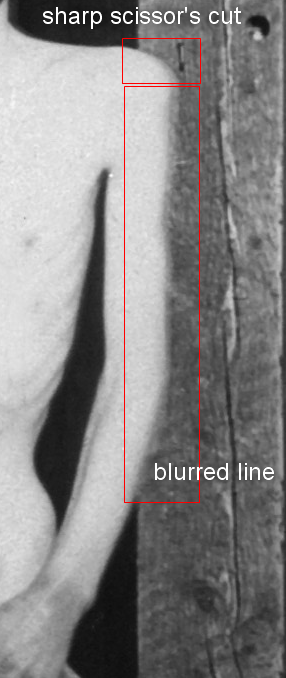 The edge of his left arm is fuzzy, as if it is drawn or painted where it meets the post (detail right). The rest of the outline of his shoulders and arms is very sharp, as though cut with scissors. [In most large-scale reproductions of this photo we have seen (as shown on the Winston Smith Blog), the left edge of the arm is cropped because the larger the image the more noticeable it is.
The edge of his left arm is fuzzy, as if it is drawn or painted where it meets the post (detail right). The rest of the outline of his shoulders and arms is very sharp, as though cut with scissors. [In most large-scale reproductions of this photo we have seen (as shown on the Winston Smith Blog), the left edge of the arm is cropped because the larger the image the more noticeable it is.- Notice the blinding whiteness of his torso, and how different it is from his face, hands and legs which are darker (top photo again). The more one studies the torso and arms, the more they look like a drawing rather than a photograph. Notice how faint are the nipples and definition on his chest compared to the man in the lower bunk who is pushing himself forward the better to be seen.
- Notice the relaxed, almost dreamy expression on the face of the standing man (detail below): his lips are parted in a smile; his eyes are looking off into the distance, not at the photographer. He appears in an untroubled state of mind, unsuited to the environment he’s in and unlike the other men .

- 5. A light source seems to be coming from above right as we face the photo, but the shadows on the legs and feet suggest a light source directly from above. Also, the angle of the shadows on the floor made by the post and by the right leg of the standing figure are not aligned.
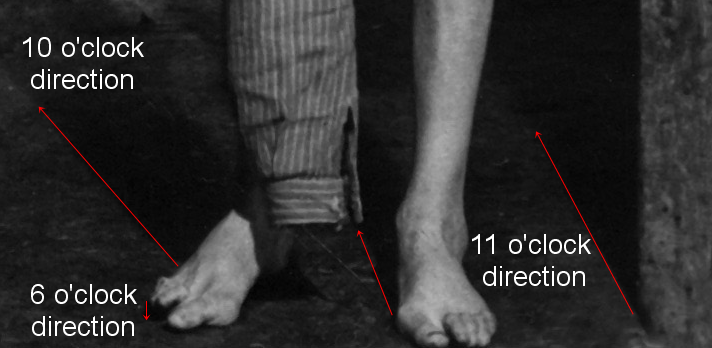
6. Ask yourself why he would be standing there completely nude, with that unlikely expression on his face, five days after the liberation? Also ask yourself why these men would still be lying in these bunks fully dressed, though some having taken their shirts off for effect, five days after the liberation? The only answer is that it’s a staged, arranged photo-shoot for propaganda purposes, not an impromptu entry by a photographer right at the time of liberation – as we are led to believe (because we are supposed to believe it) by the captions that accompany the photo. For example, in the Moberly (Missouri) Monitor-Index on April 30, 1945, the caption to this photo reads: “Slave laborers in their crowded rough bunks in the Buchenwald concentration camp near Jena, Germany, as they were found when U.S. troops of the 80th Division entered the camp.”
Fakery such as this is common in war propaganda; it just usually doesn’t last so long
We not only have the NYT newspaper article showing the photograph without the standing man, but we can also point out tell-tale signs that this figure was added to the photo … and that it was itself doctored to show a very skinny torso of a “starving” man. What deceit! If Eisenhower propaganda specialists had really found such scenes, they would not have had to invent them!
And yes, I’m asking how many personnel were aware, had to be aware, of this type of forgery. And some still living who are still perfectly aware that “The Holocaust” was and is a post-war intelligence operation with no holds barred. For example, so many of the photos that are archived and sold to the gullible public by the propaganda mill that goes by the name of the United States Holocaust Memorial Museum (USHMM) (using your tax dollars) are wildly mislabeled. The USHMM identifies this very photograph as follows:
Former prisoners of the “little camp” in Buchenwald stare out from the wooden bunks in which they slept three to a “bed.” [Photograph #74607]
Elie Wiesel is pictured in the second row of bunks, seventh from the left, next to the vertical beam.
The man in the bottom left hand corner has been identified as Michael Nikolas Gruner, originally from Hungary, Gershon Blonder Kleinman or Yosef Reich. Isaac Reich is in the bottom row, second from the right and Max Hamburger is on the bottom row, fourth from the left. Perry Shulman from Klimitov, Poland is on the top bunk, second from the left (looking up). The man in the second row, third from left has been identified as Dawid Najman. The man in the second row, fourth from the left has been identified as Abraham Hipler; Berek Rosencajg from Lodz or Zoltan Gergely from Cluj. The man on the third bunk from the bottom, third from the left, has been identified as Ignacz (Isaac) Berkovicz, Abraham Baruch and Paul Argiewicz . Juraj (now Naftali) Furst is pictured in the third bunk, fifth from the left. Standing on the right is Chaim David Halberstam.
Others say the standing man is Simon Toncman, who after the ‘Liberation’ returned to his home country The Netherlands, started a family and became a successful businessman. He refused to talk about this photo until the day he died. 2 (Why would that be? Because he knew it was a fake! And because he had been told to keep quiet about it. That’s the best, and only reasonable explanation.)
Of the identified men, one is definitely mis-identified! — and that is Paul Argiewicz. The real Paul Argiewicz was discovered by furtherglory; I picked up his work here (scrowl down to the German drivers license). How could the “Jewish Organizations” with access to Bad Arolson get that so wrong? They all do it all the time. For example, the ‘meantime -Allen Hall” article says that “Red Cross records show Heiman Leefsma survived Barrack 56 as a 20-year-old.” Yet when we see who he is identified as in the Flicker picture, he has a balding head and looks like the oldest man there.
And then there is Elie Wiesel! Please see especially here for proof that the man in the bunk is NOT Elie Wiesel. So that is more fakery surrounding this photo, but in this case the person was really in the original photograph, but is an unknown person. The decision to call that man Elie Wiesel was only made around 1983, with a Nobel Prize in mind.
Both the USHMM and the Allan Hall article are full of errors. There is no need for holocaust “historians,” filmmakers, or “researchers” to be concerned about accuracy — it doesn’t matter how iconic or world-famous they are. Sloppiness goes unpunished, especially since so much of it is on purpose — to deceive and keep the myth going. I will be posting about some other fraudulent pictures from Buchenwald in the future.
End Notes:
1. “US army commander General Dwight Eisenhower ordered this picture to be posted in every German town and city to show the defeated population the true meaning of Nazism,” writes Allan Hall. http://www.meantime.com.au/mean-time-articles/2008/8/12/60-years-on-the-faces-of-nazi-shame-get-their-names-back/
2. Same source (meantime.com): Quote – “Now, 63 years after they were liberated, they have been united again in print by a German newspaper granted rare access to the files of the Red Cross Tracing Service at Bad Arolsen, Germany.
Using the original German SS registration cards and the camp’s “Todesbuch” – book of death – researchers were able to match up names with Jewish organisations around the globe.
Paul Argiewicz, 82, is now living in the US. He lost his parents in the gas chambers and is a regular on American TV shows talking about his experiences.
Red Cross records show Heiman Leefsma survived Barrack 56 as a 20-year-old. A Dutch national, he vanished shortly after liberation and inmate 130305 has not been heard from since.
Nikolas Gruener, now 80, is a Hungarian Jew who was suffering from TB at the time of liberation. “We warmed ourselves on the bodies of the dead before they cooled down,” he said. A successful businessman after the war, he took part in a number of interviews recently for director Steven Spielberg’s Holocaust archive. He lost his parents and two brothers in the camps.
Max Hamburger is now 88. He was active in the resistance in Amsterdam. He survived the death factory of Auschwitz because he was employed as a medic and went on to Buchenwald, where he weighed just 19 kilograms at liberation. After the war he settled in Belgium,where he became a psychiatrist. He speaks regularly to universities about the Holocaust and his experiences.
Nobel Prize winner Elie Wiesel is one of the most well-known Holocaust survivors. Wiesel, who coined the phrase “never again”, is now 79. He was awarded the peace prize in 1986. “That is me,” he said, when shown the photo in the 1960s.
Simon Toncman, a Dutch Jew, was 28 at the time of liberation. He married a survivor from Auschwitz and went on to have a successful career in accountancy in his homeland before dying from a genetic bowel complaint in 1975. He never spoke about his Holocaust experiences but revelled in his “wonderful family life”. He had nine grandchildren before his death.
Mel Mermelstein, 81, is a Hungarian Jew whose whole family perished in Auschwitz. He was portrayed by Leonard Nimoy in a 1991 movie called Never Forget, about his lawsuit against Holocaust deniers in America who suggested the gas chambers were a myth. His autobiography is called By Bread Alone and he too speaks regularly about his time in the camps. Of the photo, he said: “We were alumni of some of the most terrible places on earth. This picture and the men in it mean more to me than I can say.”
The Famous Buchenwald Photo
Famous Photo of Buchenwald survivors
By Carolyn Yeager – Last updated on May 22, 2013
The following photo analysis is indebted to the two blogs that appeared on Scrapbookpages Blog on March 2nd and March 25, 2010. They can be found at: Scrapbookpages Blog / Famous Photo of Buchenwald survivors and Scrapbookpages Blog / Famous Photo of Buchenwald survivors revisited. I am also indebted to Winston Smith Ministry of Truth website for the New York Times Magazine May 6, 1945 photo captures.
This famous photo of the Buchenwald survivors is said to have been first published in the New York Times on May 6, 1945 with the caption “Crowded Bunks in the Prison Camp at Buchenwald”. We were always told it looked like this:
However, the actual picture in the May 6, 1945 New York Times looked like this:
Where is the standing man? Not there. I have written about this here.
Things to notice: Besides the missing standing man, we can also see in the above picture that the last two vertical posts are missing the part below the bottom horizontal sleeping shelf. In other words, the “feet” of the posts, the part that touches the floor, are not there. (This has been noticed and remarked on by Eric Hunt) It begins with the post that is at the end of where figures are seen in the bunks. The standing man covered up this anomaly – without him, the rest of the bunks receding further into the distance are seen to be completely empty. These are just some of the questions surrounding this piece of propaganda.
The entire page looked like this:
The photograph is said to have been taken inside Block #56 by Private H. Miller of the Civil Affairs Branch of the U.S. Army Signal Corps on April 16, 1945, five days after the Buchenwald camp was liberated (1) by a division of the US Third Army on April 11, 1945. None of the men were identified at that time. It was supposed to represent a typical chance encounter by the photographer in the liberated camp.
However, I have discovered and written about other serious anomalies in this photograph here, here, here and here, indicating that it is anything but a casual encounter with men in a barracks as it appeared in the final version of this photo. It is a major propaganda effort, a composite-photo of yet unknown extent of tampering, but it’s clear that figures have been added into the bunks that were not originally there and many people are misidentified.
Above, you see a traveling exhibit of huge, larger than life size photographs from the National Socialist camps, including Buchenwald, being shown in St. Louis, MO in summer 1945; it was then taken to Washington, DC. The names of the liberated prisoners in the picture were still unknown, with no one asking to know who they were.
NOTE: It’s important to realize that all supposedly known persons in this photo are self-identified, except for the standing man.
Elie Wiesel identifies himself, leading others to do so
At some later date (we don’t know exactly when), Elie Wiesel, who was 16 years old on April 16, 1945, said that he was the face shown inside the red circle.(2) In October 1983 (when the campaign to get Wiesel a Nobel Prize began) this picture was published in the same high circulation Sunday New York Times Magazine in an article titled “Bearing Witness: The Life and Work of Elie Wiesel,” with this caption:
“On April 11, 1945, American troops liberated the concentration camp’s survivors, including Elie, who later identified himself as the man circled in the photo.”(3)
The exact “later” time has never been pinned down. Once Elie Wiesel identified himself in the famous picture, however, other decided they were in it too. Mel Mermelstein recalled how the picture was taken (4) in his book By Bread Alone, his biographical account of a legal battle with the Institute for Historical Review. He claims to be the face with eyes-only showing in the far upper right corner.
Miklos/Nikolaus Grüner has identified himself as the 16-year-old prisoner in the lower left corner. He is the only one who actually looks his age in that picture and he also resembles the man he is today, as seen here in 2009 holding a Swedish newspaper.
According to Scrapbookpages , an October 2008 news article published on the Sun Times news Group website , since removed, reported that Paul Argiewicz identified himself as the man whose face is shown in the circle in the photo below. He stated he was was not quite 15 years old when the photo was taken and had been in Nazi concentrations camps for 5 years!
Argiewicz says he lied about his age during the “selection for the gas chamber” at Birkenau, claiming that he was 18 years old and was experienced as an electrician so that he would be selected for work, when he was actually only 11 years old and believed he would have been sent to the “gas chamber.” Argiewicz says he could speak fluent German because his mother was from Bavaria. (How could an 11-year-old pass for 18?)
The photo below shows Pawel Argiewicz as he looked in 1946 when his picture was taken for a German driver’s license. He is obviously not the same man as the older one in the famous photo.
The two faces compared side by side.
Below is Paul Argiewicz in a photo taken March 2009. There is a clear resemblance between him and the face in the driver’s license photo. However, the man in these two photos looks nothing like the man in the photo taken in Block #56 at Buchenwald. Conclusion: Argiewicz is not in the famous photo. Too bad, Pawel, but you’re outed.
Other prisoners mis-identified
Other former prisoners who have been identified can be seen here. Simon Toncman (standing), Helman Leefsma, and Max Hamburger were all from The Netherlands, and had been sent to Buchenwald after they had been captured while working with the Dutch resistance. Strangely (compared to the others who claim to be in this photo), Simon Toncman never talked about being in this picture, according to the photo caption on Flickr – maybe because he wasn’t!
The other two are falsely identified. Leefsma is said to be born in 1924, which makes him 21 years old in 1945. But we can see that he is balding and clearly an older man, possibly even in his 40’s. Max Hamburger is self-identified, but the figure he says is himself is a poorly disguised version of the man 3rd from the left in the 2nd row. I have clearly demonstrated this here and here. Hamburger does not claim to be the man in the 2nd row, but specifically the one in the bottom row.
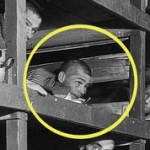 Naftali Furst, also self-identified as the man circled at left, who is 5th from the left in the 3rd row, is not in this picture either, in spite of the fact he was in the children’s barracks in Buchenwald and was photographed at liberation. He has been exposed here.
Naftali Furst, also self-identified as the man circled at left, who is 5th from the left in the 3rd row, is not in this picture either, in spite of the fact he was in the children’s barracks in Buchenwald and was photographed at liberation. He has been exposed here.
I’m also questioning whether the two heads circled in the picture at right, who are on the far left in rows two and three, are the same person. They strike me as so similar that I wonder if two shots of the same guy were added to the photo later to make the “crowded bunks” look more crowded? Why would they both be looking to the right instead of at the photographer, as the others were? What would cause them both to hide their face? The sleeping man in the second row could be the same guy.
This famous photograph was most likely elaborately staged and then “added to” as thought necessary. In any case, it is anything but a casual encounter by a liberator-photographer of the actual conditions in the camp on April 16, 1945. It is continuing war propaganda.
The orphans of Buchenwald
We look now at a photo taken on April 27, 1945—eleven days after the famous photo was taken—of Buchenwald orphans marching out of the camp with their caretakers to new lodgings in the former SS barracks. The youths and children in Buchenwald (why were they even there rather than eliminated?) had been housed in Barracks #66 in the Buchenwald “Small Camp.” Barracks #56 (for adults) was also in the “Small Camp”, which was a special quarantine section for prisoners, mostly Jews, who had recently arrived from other camps, such as Auschwitz-Birkenau.
In the photo above, the boy in front of the tall boy in the left column of boys, third from the front, (circled in red) has been identified as Elie Wiesel by Prof. Kenneth Waltzer on his Michigan State University website (now taken down). Waltzer teaches German History and directs the Jewish Studies Program at MSU. He has been writing a book for the past 6 years about the orphan boys at Buchenwald. Do the faces below, both purporting to be Elie Wiesel, look like the same person, 11 days apart? No way. Plus, could the man in the barracks be a 16-year old?
Above: man in Buchenwald barracks #56, April 16 — compared to boy in marching group, April 27.
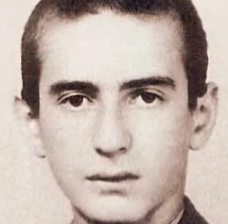 At left is a picture of Elie Wiesel at age 15, taken before his deportation. Neither of the other two pictures above claiming to be of Elie Wiesel resemble this one at all. Check the shape of the mouth and the height of the forehead. The man in the barracks also has a receding hairline.
At left is a picture of Elie Wiesel at age 15, taken before his deportation. Neither of the other two pictures above claiming to be of Elie Wiesel resemble this one at all. Check the shape of the mouth and the height of the forehead. The man in the barracks also has a receding hairline.
In addition to all these problems, Elie wrote in his book Night (and also in his 1995 memoir All Rivers Run to the Sea) that he became sick with food poisoning three days after the Buchenwald camp was liberated on April 11, 1945 and was in the hospital for two weeks. That means that it’s highly unlikely he could be in the photo of the orphans above, only one day after leaving the hospital. And he absolutely could not be in the photo of Block 56 at the top of this page, taken on April 16, unless he’s lying about being in the hospital.
In the book “The Children of Buchenwald” by Judith Hemmendinger and Robert Krell, there are the stories of 31 of the 904 orphan boys at Buchenwald, including the story of Elie Wiesel in Chapter 11. On page 113 of this book, it is mentioned that Block 66 was the barrack for the orphan boys at Buchenwald.
Jewish professor Ken Waltzer wrote, regarding the orphans at Buchenwald: “Among the older boys was Eliezer Wiesel from Sighet, Rumania, who was protected in block 66 with hundreds of others.” Waltzer also wrote in Harper’s Magazine, Dec. 31, 2008, that “Margaret Bourke White photographed [the 904 orphan boys] as did hundreds of visiting American soldiers.” Why, then, do we not see more photographs of these boys in the camp, and especially Elie Wiesel among them? Or anyone who resembles Elie Wiesel?
Miklos Grüner and Elie Wiesel were both orphans (although there is no record of Elie’s father at either Auschwitz or Buchenwald) who should have been in Block 66, the orphan’s barracks, so how did they get in a photo taken in the adult barrack, Block 56? (5)
Grüner, even though his father died at Auschwitz leaving him orphaned (6), was not sent to France with the others, but to a clinic in Switzerland because he was found to be suffering from tuberculosis. Some of the inmates in the famous photo appear to be sick, while others look healthy and of normal weight.
This suggests strongly that the photo was staged. As already mentioned, this picture was not taken on the day of liberation, but 5 days later. The photographers were setting up pictures that complemented the propaganda that was being prepared for the world. Possibly some sick prisoners were brought in to Barracks 56 to give the appearance that the general population of the camp was starving.
Below is another Buchenwald liberation photo taken on April 14, 1945, two days before the famous photo.
It shows a barrack full of Buchenwald survivors who appear to be in very good health and are warmly dressed, too. They are fully dressed while in the famous photo the sick men are shirtless to expose their bony frames. The photographer has packed the men above into this barracks to give an impression of overcrowding. Or maybe just to get as many in one picture as possible for souvenir purposes? At any rate, this is a strange comparison with Barrack 56.
Summing up
It is clear from this analysis that
A. Elie Wiesel has lied about being in this photograph.
B. Several others have also lied about being in this photograph.
C. Authorities and ‘historians’ have accepted the identity of many of the persons in this photo without any investigation – simply on someone’s say-so.
D. Only two people resemble who they say they are and that is Nikolaus Grüner (lower left) and Mel Mermelstein (upper right).
E. There are so many anomalies and unanswered questions about this photo that it must be considered 100% post-war United States “Holocaust” propaganda ordered by Eisenhower’s U.S. Army intelligence branch.
F. This photo show the level of skill in photo-manipulation that existed in 1945.
Footnotes:
- Actually, it was ready and waiting to be turned over to the United States military authorities whenever they arrived.
- The highly regarded British ‘historian’ Martin Gilbert doesn’t mention Wiesel or Mermelstein as being in the picture in The Macmillan Atlas of the Holocaust, published by him in 1982. He writes of it, “The photograph, taken on the day of the liberation of Dachau, shows some of the survivors of death marches and evacuation trains …” :-)
- Samuel G. Freedman, “Bearing Witness: The Life and Work of Elie Wiesel,” NYT, October 23, 1983.
- The July 26, 1985 Billings Gazette published an Associated Press photo showing Mermelstein holding the famous photo with the caption: “Mermelstein poses with a photograph showing himself on a bunk in the Auschwitz concentration camp.”
- In his book Stolen Identity, Grüner gives an questionable explanation on page 28. He writes that as the inmates of Block 66 were being marched toward the gate (before liberation), he faked an emergency need to relieve himself and ran to the first barrack he could reach, which turned out to be #56. There he laid down in a bunk where he remained. No way to verify this, but Elie Wiesel gives no explanation at all for why he was there. Of course, since he says he was gravely ill in the hospital at the time this picture was taken, he could not be in two places at once.
- He had an older brother and a sister who survived the camps, with whom he was put in contact after liberation. Both moved to Malmo , Sweden . (Stolen Identity, p. 29.)

